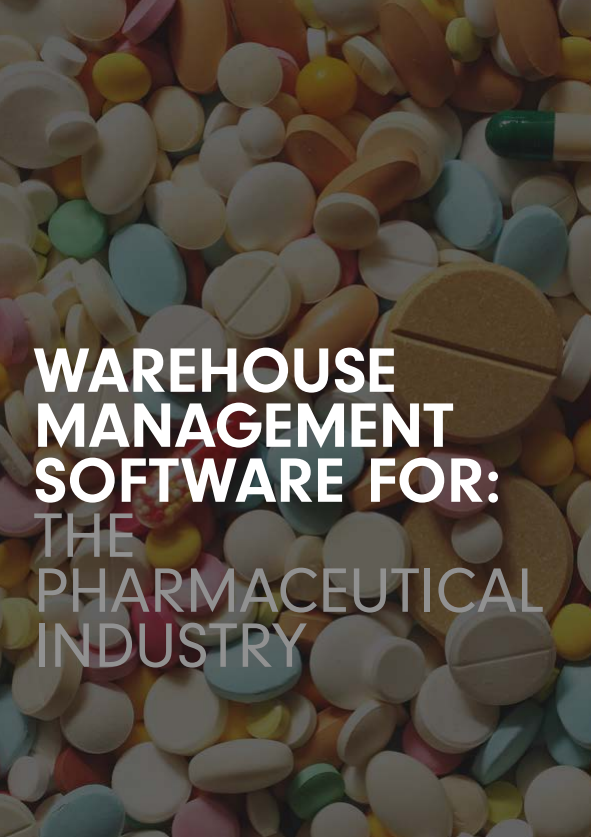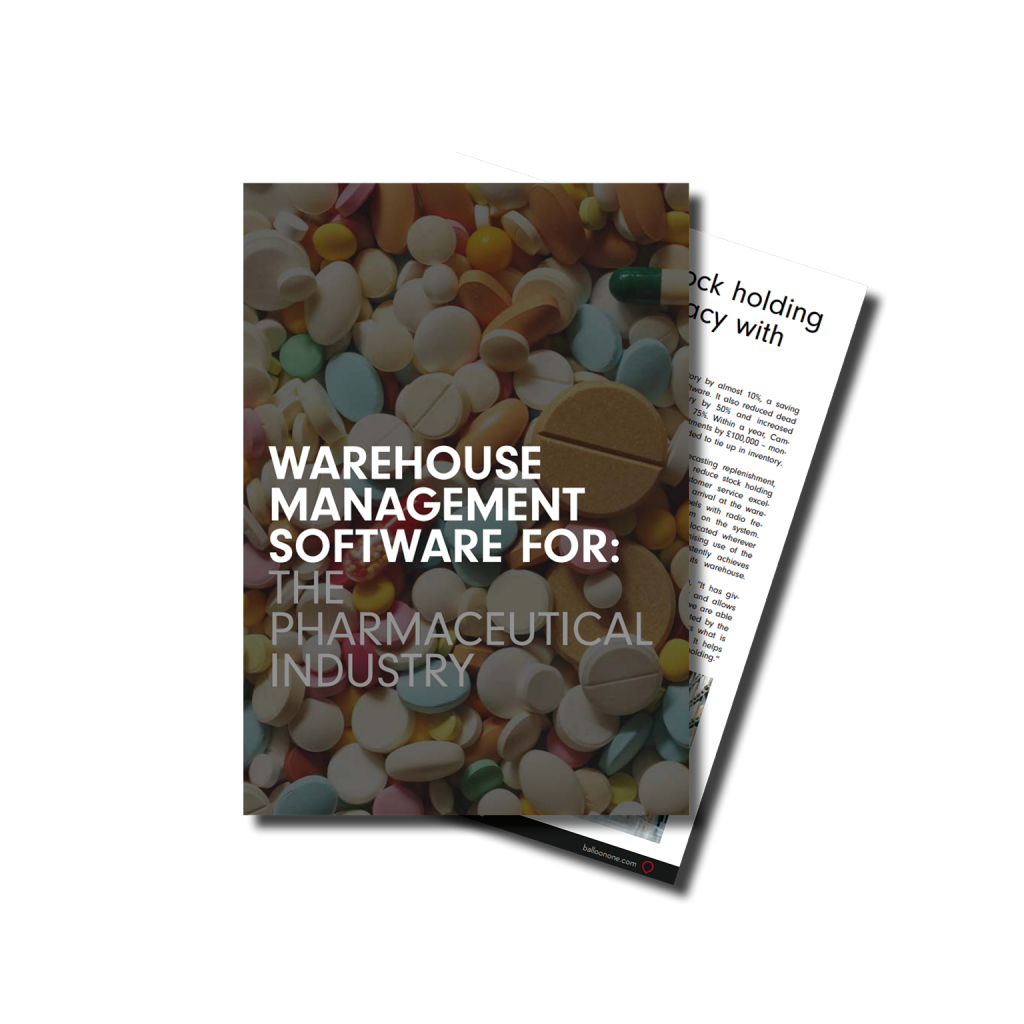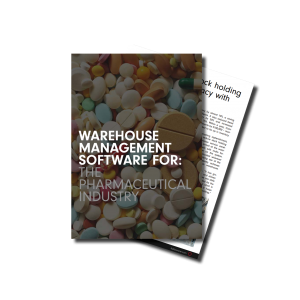
Warehouse Management Software for: The Pharmaceutical Industry.
The supply of pharmaceuticals, medicines and healthcare products is notoriously complex. There are many challenges that distributors face. While seemingly difficult to navigate, they can readily be surmounted by employing a Warehouse Management Software (WMS).
Contents:
The Challenges for Pharmaceutical Distributors
- Counterfeit and substandard medicines
- Regulatory compliance
- Ready availability and fast delivery to customers
- Safety and security during storage and handling
- Cost control
Key functionality to manage the complexities of the pharmaceutical supply chain
The challenges for Pharmaceutical Distributors.

The supply of pharmaceuticals, medicines and healthcare products is notoriously complex. There are many challenges that distributors face. While seemingly difficult to navigate, they can readily be surmounted by employing a WMS.
These are the main issues facing the industry – and are those that drive the need for warehouse management systems in pharmaceutical distribution operations.
1. Counterfeit and substandard medicines.
Counterfeit medicines are sold to unsuspecting consumers as if they were legitimate. Fake medicines not only cost the pharmaceutical companies substantial amounts of money, but they also pose a serious threat to human health. They are not regulated or subject to inspection, so may be entirely fake, with no active ingredients at all, or may contain incorrect dosages. Not only can they fail to heal or provide any health benefits, but some have also been found to contain dangerous impurities and toxic ingredients, meaning they can also actively harm those that take them.
The World Health Organisation estimates that 1% of all medicines in the developed world are counterfeit, a figure that rises to 15-30% globally. Figures claim that these falsified and substandard medicines kill around one million people every year.
The growth of ecommerce has given counterfeiters an easy way to reach their potential buyers. Without regulation or inspection, online websites allow consumers to buy directly from unauthorised sources.
To combat this upsurge in fake medicines, the EU issued its Falsified Medicines Directive – or FMD. SinceFebruary 2019, pharmacists have been required to scan medicines to confirm their legitimacy, meaning suppliers and distributors have had to comply with the directive in a number of ways.
The safety features include: packaging requirements, including an anti-tampering device, or tamper-evident features; unique identifiers, comprising a 2D DataMatrix barcode and other human-readable information; along with the EU-wide logo that identifies legal online pharmacies. New regulation was also brought in regarding the importation of pharmaceutical ingredients, meaning wholesale distributors have to adhere to some more exacting record-keeping requirements.
2. Regulatory compliance.
Aside from complying with counterfeiting legislation, there are other stringent regulations surrounding the supply of pharmaceuticals – both in the UK and beyond. There is no global regulatory framework of rules though, so supplying across multiple territories requires a thorough knowledge of the various legislative compliance needs.
The industry’s UK regulatory body, The Medicines and Healthcare products Regulatory Agency (MHRA), is responsible for ensuring that pharmaceuticals meet certain standards. Its role regarding distribution is to safeguard the supply chain. To that end, the MHRA guidance covers all manner of areas in pharmaceuticals – from manufacturing right through to distribution.
Pharmaceuticals companies are accountable to the MHRA. They are required to complete reports that are used as a basis for scoring their risk, and are subject to regular inspections by the MHRA to check that they comply with good manufacturing practice (GMP) and good distribution practice (GDP).
In the warehouse, companies can expect that their stock management is checked, and inspections are made of the stock itself and the storage areas. Temperatures are monitored and transport arrangements are assessed. To conform to the MHRS’s many guidelines involves storing, picking and shipping goods in a compliant manner.
3. Ready availability and fast delivery to customers.
Whether they are pharmacies, hospitals, clinics, retailers or end-users, customers demand speedy delivery. To achieve a near-immediate turnaround, pharmaceutical distributors need to get orders picked, packed and out of the warehouse quickly. Some customers will even command a same-day delivery schedule.
To meet these rigorous needs and ensure product availability, distributors need to be able to accurately forecast and plan stock needs. Not having products readily available can mean missed sales opportunities. Apart from the obvious cases, like selling cold and flu remedies in winter or hay fever tablets in summer, pharmaceutical goods rarely adhere to predictable sales patterns. Distributors therefore need to place a heavy reliance on past sales data so that they can forecast as accurately as possible and maximise sales.
Picking and putaway processes in the warehouse also need to be flexible to account for sudden rush orders or last-minute replenishment.
4. Safety and security during storage and handling.
To ensure drug efficacy, most pharmaceuticals need to be maintained in certain conditions from the time of manufacture, during storage and right up to the point of delivery. Preventing degeneration requires precise temperatures and humidity levels. These need to be carefully monitored therefore to ensure that they are maintained within tolerances.
Safely disposing of pharmaceutical waste is of the utmost priority. Drugs that have expired, become damaged or contaminated or that are no longer required for some reason need to be correctly disposed of and recorded. Distributors cannot afford to let them get into general circulation or cause environmental pollution.
Another concern for pharmaceutical distributors is ensuring that products are kept safe and secure during storage and transportation – especially valuable medications or those that can be used to make illicit drugs. This includes ensuring accurate stock takes and cycle counts, as well as being able to identify staff duty times so as to help prevent internal theft. The integrity of the ongoing supply chain is paramount too. Distributors need to be alert to opportunities for theft once products have left the warehouse.
5. Cost control.
Just as markets were beginning to recover from the effects of the financial crisis and 2008 recession, the pandemic hit. Economies across the globe were affected by COVID-19 and lockdowns, and this included the pharmaceutical sector. Many medical supplies companies, of course, saw growth as customers clamoured for their products. But the pandemic also saw the pharmaceutical industry thrown into considerable crisis as demand for some products grew and supply shortages exerted enormous pressures on the supply chain. Some pharma companies responded to the pandemic by investing heavily in research and development to help in the search for treatments and vaccines to tackle the virus, involving substantial costs.
This R&D spend, along with the additional logistics costs of swiftly getting products into the marketplace, has impacted profits and represents an ongoing reason that pharmaceutical companies are looking to minimise costs so that they can deliver shareholder value.
Despite tariffs having declined in general across the world this century, many territories still apply tariffs up to 20% on pharmaceuticals. This adds to the pressures for distributors who rely on international business.
End-user prices drive consumer choice and for many medicines and devices providers, the prices they are able to supply at will dictate their success. Throughout the industry, warehousing and distribution costs are under scrutiny. Companies that can optimise picking, improve productivity, and maximise efficiency will keep their costs in check and enhance their chances of market success.
Key functionality to manage in a pharmaceutical warehouse.

In solving these challenges, distributors in the pharmaceutical and healthcare supply chain depend on feature-rich warehouse management systems. These help them overcome the challenges and optimise their supply chain for greater productivity and prosperity.
Below are the key features required in a WMS that help pharma businesses comply with sector regulations, ensure secure and safe provision of goods, and provide speedy delivery to customers at a profit.
1. Falsified Medicines Directive compliance.
One of the mandates of the Falsified Medicines Directive (FMD) is that packaging should include a unique identifier in the form of a 2D DataMatrix barcode. To comply with the FMD, there are two aspects to consider.
Firstly, the WMS needs to be capable of parsing the barcode information. This is a GS1 2D DataMatrix barcode, which includes batch number, expiry date and a unique serial number.
Secondly, a risk-based verification against the UK National Medicines Verification Organisation – SecurMed – must be made at key touchpoints. For example, checks are made when stock is received, then when it is moved, and finally when it is picked for despatch. This is a two-way communication process. The UK National Medicines Verification System (NMVS) logs the information and then provides a status report back to the medicines distributor. Primary wholesalers that buy from the original manufacturer or Marketing Authorisation Holder (MAH) do not need to undertake risk-based verification, as the product is already coming from a trusted source.
The verification allows distributors to identify the status of the medicine pack. If it’s reported as active, then all is well. But if it’s reported as inactive, then the reason why will be advised. This could be that the medicine has been stolen, recalled or withdrawn. Or it may be identified as having already been dispensed or locked temporarily during an investigation.
Prescription medicines have an additional identifier. For this, the WMS also needs the ability to handle the decommissioning of the medicine. Article 23 of the FMD states that wholesalers may be required to verify the medicine’s safety features and decommission the medicine before supplying it to organisations that are not dispensing hospitals or pharmacies. For example, a wholesaler may need to decommission medicines that it supplies to universities, research bodies, veterinary practices and government bodies.
The best solutions automatically link the WMS and Enterprise Resource Planning (ERP) system to UK NMVS. In this way, there is no manual admin required and the systems are fully integrated, carrying out seamless risk-based verifications. They should also handle full Global Trade Item Number (GTIN) identification, barcode parsing and transactional history recording.
2. Traceability and serialisation.
Tied in with the concerns of the FMD, there is a need to track and trace stock through the supply chain, in real time. Inventory tracking and complete traceability from receipt to final delivery is vital in upholding the confidence of customers, suppliers, partners and regulatory bodies…
Unlock more...
Download the full ebook: Warehouse Management System for the Pharmaceutical industry.

Frequently Asked Questions.
Warehouse management software (WMS) designed for medical and pharmaceutical warehousing helps maintain strict regulatory compliance by tracking pharmaceutical products across all stages of storage and distribution. This includes automated record-keeping for audit trails, adherence to product quality standards, and support for regulatory standards to ensure safe handling and storage of sensitive items.
WMS for the medical and pharmaceutical industries includes advanced features for monitoring temperature, humidity, and storage conditions. This level of control helps prevent quality degradation and ensures that pharmaceutical products remain within required environmental parameters, reducing the risk of product spoilage or non-compliance.
A WMS tailored to the pharmaceutical sector addresses specific needs like controlled storage conditions, batch tracking, and compliance with regulatory standards. These features help warehouses maintain the integrity of pharmaceutical products, from storage through distribution, ensuring quality and safety are upheld at every stage of the supply chain.
